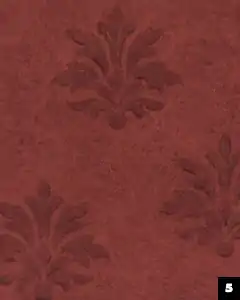Rag painting or ragging is a form of faux painting using paint thinned out with glaze and old rags to create a lively texture on walls and other surfaces.[1][2]

Ragging can be done as a negative or positive technique. The former involves rolling glaze over the entire surface, and removing it with clean rags to reveal the underlying paint color in a pleasing textural pattern. The latter is accomplished by applying glaze directly to the wall with a rag, and creates a similar pattern. Ragging is a very adaptable finish that can be used in a variety of areas, creating the illusion of an old world texture, but on a flat surface that can be easily painted over.
Ragging can be done in a variety of patterns, including rag rolling, in which the rags are twisted together and then rolled over a wet glazed surface creating the illusion of fabrics such a velvet or silk. Ragging is also often used as a pattern underneath stenciling.
See also
References
- ↑ Wolf, R. Craig; Block, Dick (2013-03-29). Scene Design and Stage Lighting. Cengage Learning. pp. 190–192. ISBN 978-1-285-68750-6.
- ↑ Wertkin, Gerard C. (2004-08-02). Encyclopedia of American Folk Art. Routledge. p. 620. ISBN 978-1-135-95615-8.